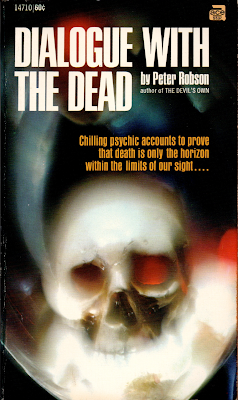Check out that skull, very cool! It's a new year, but the same old ghosts and ghouls (plus or minus some fresh faces) in Peter Robson's Dialogue With The Dead! Robson delivers a mincemeat volume with some beefy chapters, albeit organized like your usual scattershot psychic reader from Steiger or Smith - there's no real structure other than one chapter after another, and the book comes to a dead stop after the last chapter. Throughout Robson gives us credulous summaries of various spiritualists and mediums, with some interesting spikes here and there. Let's join hands and try not to tip the table as we start our dialogue with the dead!
Robson plays hardball with us bloggers in 2023, filling his 1970 text with personalities who often lack even the barest wisp of a wikipedia page. Mediums like Jordan Gill, Florence Derbyshire, Marjorie Staves, and Eileen Blaschke of the Spiritualist Association of the United Kingdom don't have a digital footprint nowadays, beyond some scattered artifacts like an ad for Blaschke's appearance at a spiritualist meeting:
The ad's from the December 12th, 1940 issue of Light, a journal of spiritualism, psychical, occult, and mystical research founded in 1881! More fleshed out titans like Eileen Garrett, Hester Dowden, Harry Price, and Geraldine Cummins crop up, as do other unknown characters like Estelle Roberts, Mrs. Murphy Lydy, and John McShayne. McShayne channels an old coot miner to find a lost gold strike in California! Robson claims a skeptical, hard nosed attitude, but it's easy to see he's posing. He pretty much lays out every medium story and then says, pretty wild, huh? An interesting detail is how many of the spiritualists rely on spirit guides who are supposed Native Americans with names like Red Cloud, Sunflower, Creeping Bear, and the like. A cheap cardboard cutout of indigenous culture is raised to support settler fantasies.
Like Steiger and Smith, Robson isn't above filling out page counts with what seem to be totally bogus stories. A high ranking Nazi flees to Nepal and spends decades meditating on his sins in a monastery until Finnish diplomat's wife Birgitte Valvanne come knocking. Suddenly, the big shot Nazi - could be Bormann, could be Mengele - feels the souls of all his victims crying out and, overcome with guilt, flees into the mountains to be devoured by snow leopards! We know today that Bormann died in Berlin (or did he?) and Mengele lived out his days in South America, but I doubt there was any real Hitlerite at the core of the tale to begin with. This chapter also has a brief mention of "snow devils," also known as the yeti.
Another intriguing ghost story, also totally unsupported, is about OGPU agent Leon Ravik, an honest workin' man of the people who performs mediumship on the side. His probings lead him to the tiny village of Ponow, some 90 miles south of Moscow, where an enclave of Old Believers are living with a dark past - a secret massacre of fellow believers that goes back to a Tzarist (note the odd/old style spelling) census/religious admonition way back in 1890 ... let's just say, the village decided to repent their schism from the mother Church with some good old fashioned decimation! Ravik sets things right and the victims are reburied with full rites and honor. Ravik later defects to the west via Latvia, but unfortunately the internet has nothing on him. It's likely the whole story is bunkum!
Another goofy ass chapter deals with Francisco Candido Xavier, a Brazilian spiritualist who channeled new books and poetry from famous dead authors. Robson gives Xavier entirely too much credit, wondering how an "illiterate peasant" could possibly achieve such wonders ... that's an old song, saying that so-and-so is just too rock stupid or low class to do such-and-such hoax. Says Robson, describing Xavier's motivations, “His interests became those of primitive people everywhere: for comfort and culture, his thoughts turned to religion and spiritualism.” At least we get a glimpse into Portuguese literature, as Xavier mostly ghostwrote from that canon.
The tragic case of inventor Edgar Vandy leads to one of the better chapters. Vandy drowns in a pool and his brothers George and Harold enlist multiple mediums to try to suss out his final moments and the secret of his last, unfinished invention: the Lectroline! It's some kind of printing contraption, best we can tell. Robson excerpts large chunks of their medium sessions, complete with the brothers' canny, critical, but scrupulously fair notes. Of one leading probe offered by a medium, Harold says, "This question is framed in such a way that a shrewd person might think of something electrical at once." Nice work Harold! George and Harold note when mediums achieved "hits" and when they miss the mark by a country mile, which is often. Robson can't avoid concluding that all the mediums employed failed to reconstruct the Lectroline, though George and Harold did achieve some closure with their brother's passing.
Other bits involve Elizabethan era polymath John Dee, Air Chief Marshall Hugh Dowding and his quest for his fallen airmen, Arthur Conan Doyle's meeting with Lenin's ghost, Nandor Fodor investigating a poltergeist in Sussex, and a phony medium named Frank Hartley who accidentally ends up channeling a real spirit! The final chapter is on the 1844 occurrence of some creepy moving coffins in Ahrensburg, on the island of Oesel in the Baltic Sea. Moving coffin stories must have been popular in the 1800s, as the Chase Vault in Barbados is also mentioned by Robson. Once this chapter is done, the book just ends!
Ace Books, 1970









No comments:
Post a Comment